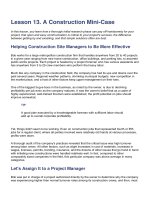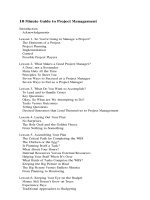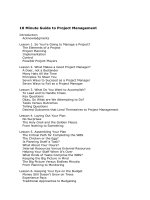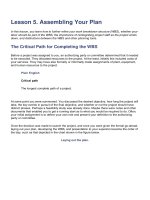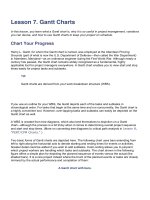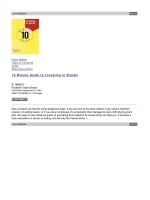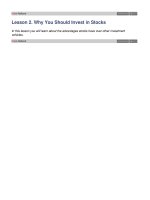10 Minute Guide to Investing in Stocks Chapter 9 pdf
Bạn đang xem bản rút gọn của tài liệu. Xem và tải ngay bản đầy đủ của tài liệu tại đây (350.18 KB, 9 trang )
I l@ve RuBoard
Lesson 9. Opening a Brokerage Account
In this lesson you will learn about the various types of brokerage accounts that are available
and the differences in how they operate.
I l@ve RuBoard
I l@ve RuBoard
Getting Started
Opening a brokerage account is a relatively simple procedure. On average, most brokerage
firms will open an account for about $2,500. However, as this is an average, the initial
amount may vary. Many brokerages offer accounts at various levels with a number of
enticements to make the investor open the account with as much money as possible. Open
an account at $10,000 and you get a toaster. Open an account with $100,000 and someone
from the brokerage will come to your house to make the toast. See how that works?
In all seriousness, the fight for new investors is fierce and you can make out as the various
brokers battle for your business. Most e-brokers are currently offering everything from
reduced trade prices to outright free trades for an extended period of time, a year for
example, if you commit to keeping your account with them. Whether you open an account
online, by telephone, or in person, be sure and ask what kind of perks are available or you
might miss out on a great deal.
In addition, regardless of what type of broker you will be using, it's probably a pretty good
idea to get information on a couple of different ones before making your decision. Any
legitimate broker will be happy to give you almost any type of information or reference you
wish to see.
Not all brokerages require such large initial deposits when opening new accounts. To most
people, $2,500 is an astronomical sum, and that's not so strange. The average person simply
doesn't have $2,500 lying around the house not being otherwise used. A number of
brokerages do allow smaller initial investment amounts of $1,000 or even $500. In addition,
many brokerages will allow you to open an account with a small amount if you agree to
systematic deposits. This is a great way to build up a brokerage account by opening the
account with a minimum amount, often as low as $50 or $100, and investing that same
amount each month. All you need to do is forward your bank account number and a signed
authorization and that set amount will be automatically deducted on the same day each
month.
NOTE
A systematic deposit is a predetermined amount that is regularly deposited to an
account. For example, every month on payday you send $50 to your account. This
service is offered by almost any broker.
Finally, many brokerage houses run sales. I'm not making this up. The competition for
investors has become so fierce in the last couple of years that brokerage houses will allow
clients to open accounts with amounts substantially below their normal minimum limits. After
all, it's in the brokerage's best interests to hold $200 of an investor's money rather than
nothing at all.
Fill Out This Form, Please
Once the amount has been established, you as a new investor simply fill out a new account
form just as you would at any bank. Although the information required varies, certain
information remains standard. The following list is not meant to be exhaustive, but you should
probably be prepared to supply some or all of the following information:
Your name
Your address
Your Social Security Number
The name of your bank and your account numbers there
Account numbers at different brokerages (if applicable)
Your employer
Annual income
Net worth
Your investment objectives
Citizenship
Age
In addition, when opening a joint account, your spouse will probably be required to provide all
or some of this information as well. Finally, a credit check may be run on you. Bad credit will
not necessarily prevent you from opening an account; after all, the brokerage houses don't
grow by passing up new business. However, nor do they grow by making bad decisions
regarding deadbeat clients, so it's a good idea to check your credit rating and straighten out
any discrepancies beforehand.
TIP
Getting a copy of your credit report is a good idea before beginning any financial
activity. Appendix B, "Resources," contains contact information on the two largest
credit reporting agencies in the United States. A copy of your credit report is
available free upon request from each.
Once you are fully ready to open your account, which type will you choose? The two most
popular brokerage accounts are …
Cash account
Margin account
I l@ve RuBoard
I l@ve RuBoard
Cash Account
A cash account is the more popular. It's certainly the safest one to keep you, as a new
investor, out of trouble while learning your way through the stock market. In simplest terms, a
cash account enables you to buy and sell stock in direct proportion to what is in your account.
This means that if you have $1,000 in your account, you can buy only $993 worth of stock in
XYZ Company. Wait, what happened to the other $7? It went to pay the brokerage for
placing the purchase, remember?
Plain English
A cash account is a brokerage account in which the investor can purchase stock
only in an amount equivalent to the amount of money being maintained within the
account.
It is exactly this type of example that shows the advantage of a cash account, and new
investors should strongly consider having one. With a cash account, if you had tried to place
an order for $1,000 worth of stock, the brokerage would have informed you that you didn't
have sufficient money in your account, or they simply wouldn't have placed the order.
In the worst-case scenario, the brokerage would simply either freeze your account until such
time as you coughed up the $7, cancel the purchase, or otherwise deal with the situation.
Many brokerages will still allow you to make trades, as long as you put up the cash, and will
freeze only the amount in question. In any event, you would definitely be aware of what was
going on or what had already happened, and nothing would have happened that could get
you into financial trouble.
Safeguarding Your Trades
Another way in which the cash account covers you from debt trouble in the market (never a
good thing) is by prohibiting you from purchasing stock from the subsequent proceeds of a
sale. That means you can't buy stock now with money you think you're going to make later.
For example, say you invest $100 in XYZ Company stock today, and tomorrow that stock is
worth $200, so you sell it. You can't get the $200 you would have made unless you initially
had $100 in your account to have made the first trade. "Wait a second," you say. "If you were
to have given me the $200 first, and then I were to pay back that initial $100 as if you had
loaned it to me, we would all still have come out happy, right?" Let's say for a moment that
you bought the $100 worth of XYZ Company stock with borrowed money or a credit line,
thinking the value was going to go up, and tomorrow the market tanks and your stock is worth
$10. But you've already made a second purchase for ABC Company stock with borrowed
money or a credit line, thinking you'll pay it back with the money you're bound to get from the
XYZ purchase. Since the original investment never paid off, you're in way over your head.
TIP
Beginning investors should seriously consider opening a cash account that limits
any type of financial damage from a bad investment to nothing more than the initial
amount invested. While it's not a great idea to purchase stock on credit at any time,
it's especially bad for new investors with limited experience.
It's this kind of reasoning that led to the original stock market crash. When the panic forced
all stock prices to drop, people were responsible for the amounts of their original trades.
Since they didn't actually have that kind of money, they lost their homes, savings, and
anything else of value.
If you're convinced that you're a good enough (or lucky enough) investor to avoid these kinds
of problems and pitfalls, perhaps you should consider a margin account.
I l@ve RuBoard
I l@ve RuBoard
Margin Account
In a margin account, the brokerage firm basically lends you money. However, you are still
required to maintain in your brokerage account at least half the value of the stock that you
want to purchase. A margin account enables an investor to make money faster, but be
warned: It also enables an investor to lose money faster. The process by which this works is
known as leverage as discussed earlier in Lesson 6, "Stock Derivatives," whereby
additional money or credit is applied to an investor's purchase (or sale) of stock.
Plain English
Leverage is like a seesaw: The farther you get from the center, the greater the
movement. The seats on the seesaw will go higher and lower, as will the value of
the investment in larger profits and losses.
Say, for example, that you open a margin account with $1,000. You can place a purchase
order for $1,986 worth of XYZ stock. "Wait a second," you say. "Where'd that number come
from?" First, we're assuming you're still using the same broker as in the cash account
example. You're still required to pay the $7 service charge for the purchase. This leaves you
$993 with which to buy the stock. Since you have to maintain at least half the price of the
stock purchase, the brokerage can lend you only $993, not $1,000 for the purchase.
$993 + $993 = $1,986
Next, let's say that the value of XYZ stock doubles the next day, and your stock is now worth
$3,972 ($1,986 + $1,986). You can sell the stock (the sell order will cost you $7 again), give
$993 back to the brokerage house, and pocket $2,972. Compare your $2,972 with the $1,979
the investor with a cash account would have made with the same investment ($993 + $993 =
$1,986, which is the initial amount invested and the capital gain when the stock value
doubled, minus $7 for the sale is $1,1979), and you're ahead of the other investor by $993.
So why isn't everyone using a margin account? On the other side, let's say you still make the
initial purchase of $1,986, and the next day the value of XYZ stock drops by half. Your stock
is now worth $993 and that's also the amount the brokerage lent you, so you have to repay
that amount plus the $7 for the sale order. You are effectively back at zero. The guy in the
cash account, though, is still holding stock worth $496.50 ($993 ÷ 2). Not a great day by any
standards, but still preferable to owning nothing and being $7 in debt for service charges to
boot.
One More Point
Obviously, most real-life examples aren't quite as dramatic or straightforward. Did I mention
that the brokerages will also charge you interest on the loan? So even in less dramatic
examples, the margin account investor will need to make a higher profit to come out ahead,
since the interest charges must be figured into the formula as well.
Finally, certain restrictions apply as to what kinds of stocks can be purchased or sold through
margin accounts. These restrictions are usually reserved for the more obscure stocks and
therefore don't necessarily prohibit regular day-to-day transactions.
Margin accounts certainly appeal to the risk takers. In addition, they can prove a useful tool
for someone who has the resources to back any error, but it is an area best avoided by new
investors.
CAUTION
Make sure you directly question your broker about any restrictions before opening a
margin account. As with anything dealing with money, make sure you know what
you're getting yourself into.
Drips
Direct Reinvestment Plans, or DRIPs, are an ingenious method many companies have
developed to make their stock available to individual investors without the use of a broker.
The company raises capital funds without having to go through the expense and trouble of
issuing new stock and the investor makes out by minimizing or avoiding a broker fee
altogether through purchasing stock directly from the company. In addition, many companies
will even reduce the stock price from its market price.
DRIPs are designed for investors to accumulate stock in the company by requiring
subsequent systematic purchases of the stock. To maximize that result, and because
purchases and sales of the stock are handled through the company, redeeming or selling
your shares may require a substantially longer period of time.
Most of the larger companies such as Home Depot and the Chase Manhattan Bank, for
example, offer DRIPs, although few if any are aggressively advertised. Should you firmly
believe the potential of a particular company's merits, check its Web site or contact the
company through its main number and ask about the availability and particulars of its DRIP
program.
The 30-Second Recap
The minimum amount required to open a brokerage account varies, as do potential
perks.
A cash account is a brokerage account in which the investor may purchase stock
equivalent to no more than the amount of money available.
A margin account is a brokerage account whereby an investor can purchase stock with
money loaned by the brokerage. The amount of the loan cannot exceed the amount of
money maintained within the account by the individual investor.
Direct Reinvestment Plans (DRIPs) are programs offered directly from companies
whereby potential investors make systematic purchases of the stock in return for
absorbed broker costs and reduced share prices.
I l@ve RuBoard
